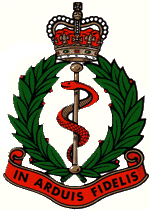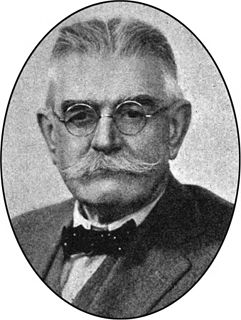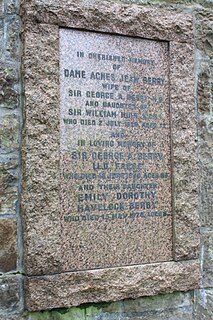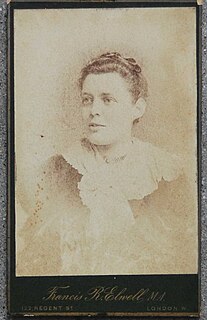

Andrew Maitland Ramsay FRSE LLD (1859–1946) was a Scottish eye surgeon and medical author. He was President of the Opthamological Society of Great Britain 1923/24 and President of the Royal Medico-Chirurgical Society of Glasgow.


Andrew Maitland Ramsay FRSE LLD (1859–1946) was a Scottish eye surgeon and medical author. He was President of the Opthamological Society of Great Britain 1923/24 and President of the Royal Medico-Chirurgical Society of Glasgow.
He was born on 9 November 1859 in Glasgow the son of Andrew Ramsay, a clothier of 66 South Portland Street on the south side of the River Clyde. [1] The family moved to West Lothian in his youth and he was educated at Linlithgow Burgh Grammar School. He then studied Medicine at Glasgow University graduating MB ChM in 1882.

Glasgow is the most populous city in Scotland, and the third most populous city in the United Kingdom, as of the 2017 estimated city population of 621,020. Historically part of Lanarkshire, the city now forms the Glasgow City council area, one of the 32 council areas of Scotland; the local authority is Glasgow City Council. Glasgow is situated on the River Clyde in the country's West Central Lowlands. Inhabitants of the city are referred to as "Glaswegians" or "Weegies". It is the fourth most visited city in the UK. Glasgow is also known for the Glasgow patter, a distinct dialect of the Scots language that is noted for being difficult to understand by those from outside the city.

Linlithgow is a town in West Lothian, Scotland. It is West Lothian's county town, reflected in the county's alternative name of Linlithgowshire. An ancient town, it lies south of its two most prominent landmarks: Linlithgow Palace and Linlithgow Loch, and north of the Union Canal.
He gained practical experience at the Glasgow Western Infirmary and the Glasgow Eye Infirmary. He gained his doctorate (MD) in 1891. [2]
In the First World War he served as a Major in the Royal Army Medical Corps at the 3rd General Scottish Hospital.

The Royal Army Medical Corps (RAMC) is a specialist corps in the British Army which provides medical services to all Army personnel and their families, in war and in peace. Together with the Royal Army Veterinary Corps, the Royal Army Dental Corps and Queen Alexandra's Royal Army Nursing Corps, the RAMC forms the Army Medical Services.
He succeeded Dr Thomas Reid as lecturer in Ophthalmology at Glasgow University and became Professor in 1936. [3]
In 1938 he was elected a Fellow of the Royal Society of Edinburgh. His proposers were Percy Herring, David Waterston, Robert James Douglas Graham, and Donald Esme Innes. [4]

The Royal Society of Edinburgh is Scotland's national academy of science and letters. It is a registered charity, operating on a wholly independent and non-party-political basis and providing public benefit throughout Scotland. It was established in 1783. As of 2017, it has more than 1,660 Fellows.
Professpr Percy Theodore Herring FRSE FRCPE LLD was a physician and physiologist, notable for first describing Herring bodies in the posterior pituitary gland.
Robert James Douglas Graham FRSE (1884–1950) was a Scottish botanist.
He retired to St Andrews at the onset of the Second World War.
He died at home in St Andrews on 20 March 1946 aged 86. [5] He is buried in the east cemetery extension to St Andrews Cathedral churchyard.
In 1906, he married Dr Elizabeth Margaret Pace (1865-1957). [6]

James Hogarth Pringle was a surgeon in Glasgow, Scotland, who made a number of important contributions to surgical practice. He is most famous for the development of the Pringle manoeuvre, a technique still used in surgery today.

Dr Douglas Moray Cooper Lamb Argyll Robertson FRSE, FRCSEd LLD was a Scottish ophthalmologist and surgeon. He introduced physostigmine into ophthalmic practice and the Argyll Robertson pupil is named after him. He was president of the Royal College of Surgeons of Edinburgh.

William Mackenzie was a Scottish ophthalmologist. He wrote Practical Treatise of the Diseases of the Eye, one of the first British textbooks of ophthalmology.

Dr Ramsay Heatley Traquair FRSE FRS LLD was a Scottish naturalist and palaeontologist who became a leading expert on fossil fish.

Robert Marcus Gunn was a Scottish ophthalmologist remembered for Gunn's sign and the Marcus Gunn pupil.

Sir George Andreas Berry FRSE was a world-leading eye surgeon and Scottish Unionist politician.
Professor Thomas Jones Mackie FRSE LLD CBE was a noted Scottish bacteriologist; Dean of the Faculty of Medicine, University of Edinburgh; and author of medical research textbooks.

Dr Marion Gilchrist was the first female graduate of the University of Glasgow; the first woman to qualify in medicine from a Scottish university; and a leading activist in the Women's suffrage Movement in Scotland. In memorial of her and her achievements she has a public park and a car park named in her honour in her native Bothwell.
Prof John Gray McKendrick FRS FRSE FRCPE LLD was a distinguished Scottish physiologist. He was born and studied in Aberdeen, Scotland, and served as Regius Professor of Physiology at the University of Glasgow from 1876 to 1906. He was co-founder of the Physiological Society.

Sir Thomas McCall Anderson (1836–1908) was a professor of practice of medicine, at the University of Glasgow.
Carl Hamilton Browning LLD FRS FRSE (1881–1973) was a Scottish bacteriologist and immunologist. He is especially remembered for his brief but important work in Germany with Paul Ehrlich. He discovered the therapeutic qualities of acridine dyes.

Diarmid Noel Paton, FRS FRSE was a Scottish physician and academic. From 1906 to 1928, he was the Regius Professor of Physiology at the University of Glasgow.
David Dale Logan was a distinguished Scottish physician, soldier and medical author. He was an expert on gas warfare, and, as an odd attachment to a medical training, was an expert mining engineer.
Dr Donald James MacKintosh FRSE CB MVO DL (1862-1947) was a Scottish physician, soldier and public health expert. Following his term serving in the Boer War he liked to be addressed as Colonel MacKintosh.
William Walker was a Scottish surgeon who specialised in ophthalmic surgery. He was Surgeon Oculist in Scotland to Queen Victoria and President of the Royal College of Surgeons of Edinburgh. He was a keen amateur photographer, whose calotypes were displayed in photography exhibitions.

Dr Henry (Harry) Moss Traquair, FRSE, PRCSE was a Scottish ophthalmic surgeon who made important contributions to the science of perimetry and the use of visual field testing in the diagnosis of disease. He was President of the Royal College of Surgeons of Edinburgh in 1939/40 and President of the Ophthalmological Society of the United Kingdom.

Dr Elizabeth Pace was a Scottish doctor, suffragist and advocate for women's health and women's rights.

Hector Clare Cameron was a surgeon who was most notable for being Emeritus Professor of Clinical Surgery at the University of Glasgow and President of the Faculty of Physicians and Surgeons of Glasgow between 1897 and 1900.
Prof George Ritchie Thomson CMG FRSE LLD (1865–1946) was a 19th/20th century Scottish military surgeon and expert on tropical medicine who served in the Second Boer War and First World War and advanced public health in South Africa.